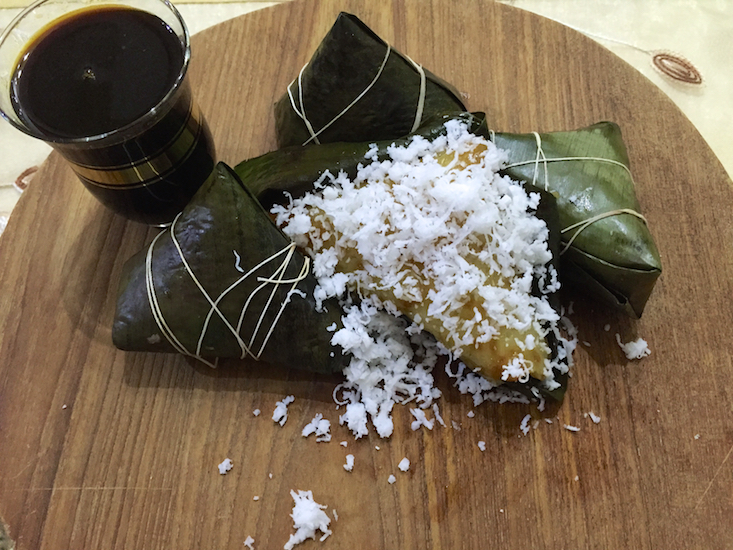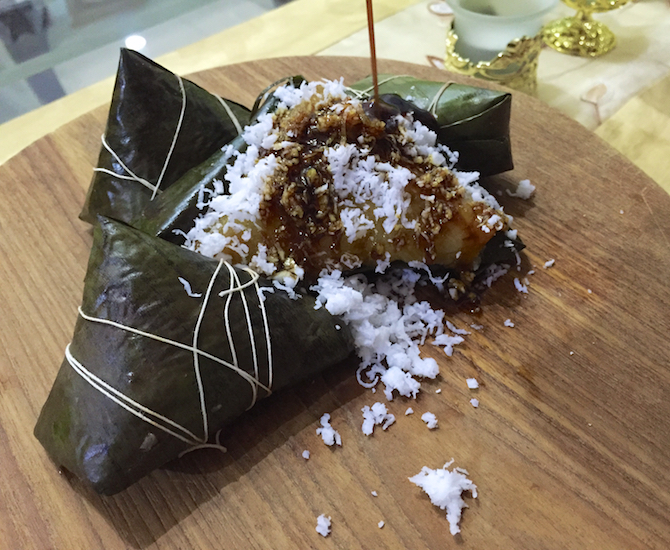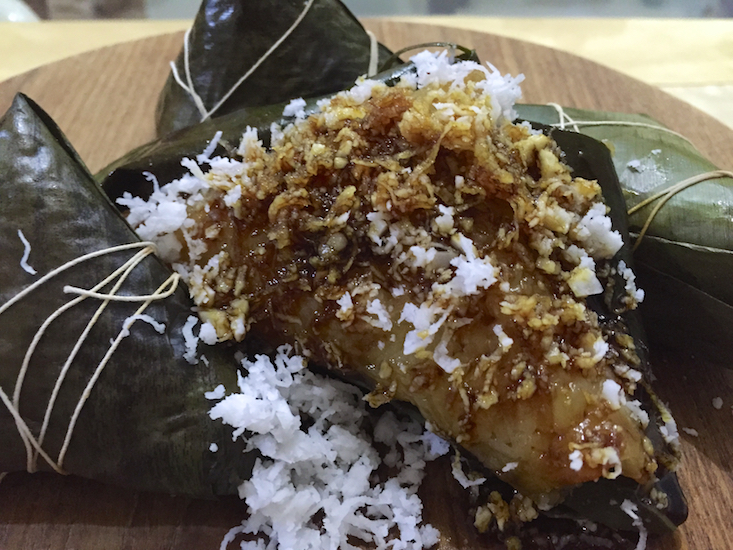
The main ingredient in this kuih (cake in the Malay language; pronounced: kway) is the glutinous rice.
It’s one of my favourite ingredients, but then I like it sweet and fragrant. I am not keen on and I do not like savoury food items using glutinous rice. Many sweet glutinous rice recipes are serikaya, wajek, chendol, pulut inti, mango with glutinous rice and the list goes on (I will post the processes of making these in due course).
As the calorie content of these sweet delicacies can go sky high, I eat it moderately. Inevitably, most Malaysian kuihs are loaded with palm sugar and coconut, which make them really delectable and so divine.

One such kuih is kuih lopes (pronounced: lo-pez). Some years ago, my aunt, who is also a very good cook, visited me with a bouquet of kueh lopes. I always thought it is very difficult to do; my aunt told me otherwise.
I took the plunge to do it myself as I could not find a good-tasting lopes in the food shops. The preparation may be a little long, but once you plan the process of making it, it becomes doable and you get immense pleasure when eating it with friends. It is a good idea to do more as it can be shared with family and friends.
Most of us like to buy it, but when you do it yourself, you can be assured of good quality ingredients and hence a very best tasting kuih, which can be eaten for breakfast or as a dessert snack (for me it’s a breakfast/lunch/dinner and anytime snack too – oh oh!! – I can never resist kuih lopes).

INGREDIENTS:
2 cups white glutinous rice
2 tbsp alkaline water
1 fresh coconut, the fleshy white part grated
3 blocks palm sugar
2 tbsp coarse white sugar
6 pandan leaves
Salt to taste
Banana leaves – for wrapping the lopes
PREPARATION:
Preparation 1 – glutinous rice:
Rinse the glutinous rice well. Soak in water (it should cover the rice) and pour in the alkaline water. Add pandan leaves (knot them first). Stir.
Leave aside for at least 6 hours or overnight.
Preparation 2 – palm sugar syrup:
Take a pan, add 3 blocks of palm sugar, 2 tbsp of coarse white sugar and 1 cup of water and let it simmer till dissolved. The syrup should be of thick, but pouring consistency. Strain into a small jug. It is alright to do more as this can be kept and used for other recipes as well (in fact, this can be used as an alternative to maple syrup).
METHOD:
Cut banana leaves to about 4 x 6 inches and soften it by toasting directly on the stove or steaming it in a steamer. Or, they can be scalded in a pan of hot water. If you want bigger triangular parcels, then cut the banana leaves to about 6 x 8 inches.
Meanwhile, remove the pandan leaves from the soaking glutinous rice, give it a rinse, drain completely. Mix in ½ tsp salt.
Place 3 tablespoons of rice onto 1 banana leaf and fold it into a triangle. Secure with a thin rope or use a strand of banana leaf. Make sure that it is secured well as the rice should not leak out while boiling. Complete the process.
Boil water in a big pot with 3 knotted pandan leaves. Place the triangular parcels in the pot and let it simmer for 1 to 2 hours. The parcels must be immersed in the water completely. You may add hot water time to time if necessary. The longer it boils the longer the lopes can be kept (up to 2 weeks in the fridge).
Drain completely. Cool it and tie the parcels into a bouquet and let it hang. Keep aside.
Mix in a pinch of salt to the grated coconut, add some pandan leaves and steam it for 5 minutes. Keep aside.
To serve, unwrap banana leaves from one triangular parcel. Roll it in the steamed coconut. Put it on a serving dish. Pour the palm sugar syrup and enjoy!
Notes:
Choose your ingredients well. The quality of the ingredients will make a great tasting kuih.
For the glutinous rice – when buying, make sure it is not combined with white rice.
For the palm sugar – choose the dark variety. When you press it with your finger, the sugar block should give in a little.
If banana leaves are unavailable, you may use quality bags which can withstand boiling. Or you may put all the rice in a cooking foil and form a roll. Make sure both ends are well secured and tight. Use a large pot to immerse this roll. To serve, unwrap and cut the roll into slices, top with coconut and palm sugar syrup.
The cooked lopes can be kept in the fridge for about 2 to 3 weeks if left unwrapped. Once unwrapped, serve it quickly. Although, rarely can I keep it more than 3 days – it just vanishes into someone’s stomach!
https://waterfallmagazine.com
I do accept as true with all of the concepts you have offered in your post.
They’re really convincing and will certainly work. Still, the posts are too brief for
beginners. Could you please lengthen them a little from next time?
Thank you for the post.
Thank you Junkocochran. I will take in your feedback.
Chef renga